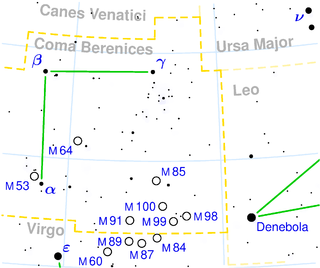蜻蜓44星系
外观
| 蜻蜓44星系 | |
|---|---|
 | |
| 观测资料 | |
| 星座 | 后发座 |
| 赤经 | 13h 00m 58.0s[1] |
| 赤纬 | +26° 58′ 35″[1] |
| 视星等 (V) | 22.0; 19.4 [1] |
| 特征 | |
| 大小 | 70,000 |
| 其他名称 | |
| SDSS J130057.99+265839.7 | |
蜻蜓44星系是后发座星系团中的一个超稀疏星系[2][3][4]。根据观测其旋转速度判断其质量为一万亿太阳质量,约和银河系的质量相同。这也和周围观测到的90个球状星团一致。不过此星系发出的光只有银河系的1%[5]。该星系由蜻蜓望远镜头阵列(Dragonfly Telephoto Array)发现[6]。
2016年8月时,科学家指出蜻蜓44星系几乎完全是由暗物质组成[7][8][9]。
相关条目
[编辑]参考资料
[编辑]- ^ 1.0 1.1 1.2 Van Dokkum, Pieter; et al. Spectroscopic confirmation of the existence of large, diffuse galaxies in the coma cluster. The Astrophysical Journal Letters. 1 May 2015 [1 September 2016]. (原始内容存档于2021-03-30).
- ^ Scientists discover the fluffiest galaxies. phys.org. 14 May 2015 [2016-08-31]. (原始内容存档于2016-08-26).
- ^ Van Dokkum, Pieter; et al. Forty-seven milky way-sized, extremely diffuse galaxies in the Coma-Cluster. The Astrophysical Journal Letters. 7 January 2015 [31 August 2016]. (原始内容存档于2017-06-06).
- ^ Dragonfly 44: Ultra-Diffuse Galaxy Made Mostly of Dark Matter. Aug 2016. [2016-08-31]. (原始内容存档于2020-11-12).
- ^ Crosswell, Ken. The Milky Way’s dark twin revealed. Nature News. 26 July 2016 [30 July 2016]. (原始内容存档于2016-10-13).
- ^ Rachel Feltman. A new class of galaxy has been discovered, one made almost entirely of dark matter. Washington Post. 25 August 2016 [2016-11-01]. (原始内容存档于2020-12-02).
- ^ Van Dokkum, Pieter; et al. A High Stellar Velocity Dispersion and ~100 Globular Clusters For The Ultra-Diffuse Galaxy Dragonfly 44. The Astrophysical Journal Letters. 25 August 2016 [27 August 2016]. (原始内容存档于2019-08-30).
- ^ Hall, Shannon. Ghost galaxy is 99.99 per cent dark matter with almost no stars. New Scientist. 25 August 2016 [27 August 2016]. (原始内容存档于2019-04-11).
- ^ Feltman, Rachael. A new class of galaxy has been discovered, one made almost entirely of dark matter. The Washington Post. 26 August 2016 [26 August 2016]. (原始内容存档于2018-04-02).
| 这是一篇与天文学相关的小作品。您可以通过编辑或修订扩充其内容。 |
